Looking for a Reliable LED Linear Light Manufacturer in China?
LED Linkable Linear Light
REQUEST A QUOTE FOR MORE DETAILS
LED Linear Lights: The Ultimate Guide for Selection, Customization, and Key Components
Introduction:
When it comes to high-efficiency, modern lighting solutions, LED linear lights stand out as one of the best choices for a wide range of applications. Whether you’re outfitting a commercial office, industrial warehouse, or high-end retail space, LED linear lights provide unmatched energy efficiency, long-lasting durability, and versatility.
In this guide, we’ll dive deep into the technical aspects of LED linear lighting, focusing on its core components:
Housing
LED Chips
Optics (Lens)
PCB (Printed Circuit Board)
Drivers
Additionally, we’ll explore customization options and compliance standards such as CE, RoHS, EMC, and photobiological safety to ensure your lighting solution is both high-performing and compliant. By the end of this guide, you’ll have all the knowledge you need to select the ideal LED linear light for your unique project.

Understanding LED Linear Light Components
A modern LED linear light is more than just a strip of LEDs – it’s a finely engineered luminaire composed of several key components working in harmony. Understanding each part (and its impact on performance and durability) is crucial when comparing products or planning a project. Below, I’ll break down the major components of an LED linear light fixture: Housing, Lens, LED Chips, PCB, and Driver – explaining their construction, material choices, and roles in the overall system. By the end of this section, you’ll know exactly what to look for in a high-quality linear fixture and why each piece matters.

1. Housing in LED Linear Lights: Why It Matters & What to Look For
The housing of LED linear lights is more than a shell; it’s the foundation that influences performance, longevity, heat dissipation, and aesthetics. A quality housing ensures that internal components remain protected while contributing to the fixture’s efficiency and visual appeal.
1.1 Material: Why Extruded Aluminum?
High-quality LED linear lights are typically made from extruded aluminum, a process where aluminum is heated and pushed through a shaped die to create a continuous profile. Here’s why this material is the ideal choice for the housing:
Lightweight Yet Strong: Aluminum is light but sturdy, making the fixture easy to handle while maintaining structural integrity.
Consistent Shape & Stability: Unlike cheaper plastic or steel, aluminum maintains its form over time, even in long fixture runs, preventing warping or sagging.
Sleek & Professional Finish: Aluminum can support anodizing or powder coating, providing a durable and visually appealing finish that resists scratches and corrosion.


1.2 Thermal Management: How It Helps LED Performance
The housing doesn’t just serve as an outer shell; it also acts as a heat sink, playing a pivotal role in cooling the LED chips and electronic components. Here’s how it supports thermal management:
High Thermal Conductivity: Aluminum draws heat away from the LEDs and PCB, ensuring that components don’t overheat.
Extended LED Lifespan: By keeping the temperature low, the housing extends the lifespan of the LEDs and maintains consistent brightness.
Optimized Heat Dissipation: Some designs include fins or grooves that increase surface area, improving cooling efficiency.
By preventing heat buildup, a well-designed housing ensures the LEDs maintain their peak performance over time.
1.3 Durability: Built to Last
A premium housing not only protects the internal components but also ensures that the fixture will perform reliably for years. Here’s how a high-quality housing enhances durability:
Robust Construction: Aluminum keeps the LED chips and PCB firmly in place, preventing movement that could cause damage.
Corrosion Resistance: Anodizing or powder coating protects the housing from rust, corrosion, and wear, ensuring it remains functional even in challenging environments.
Environmental Adaptability: Many high-quality housings are rated for outdoor use or high-humidity conditions, featuring water-resistant designs.
A durable housing means fewer replacements and reduced maintenance costs over time.

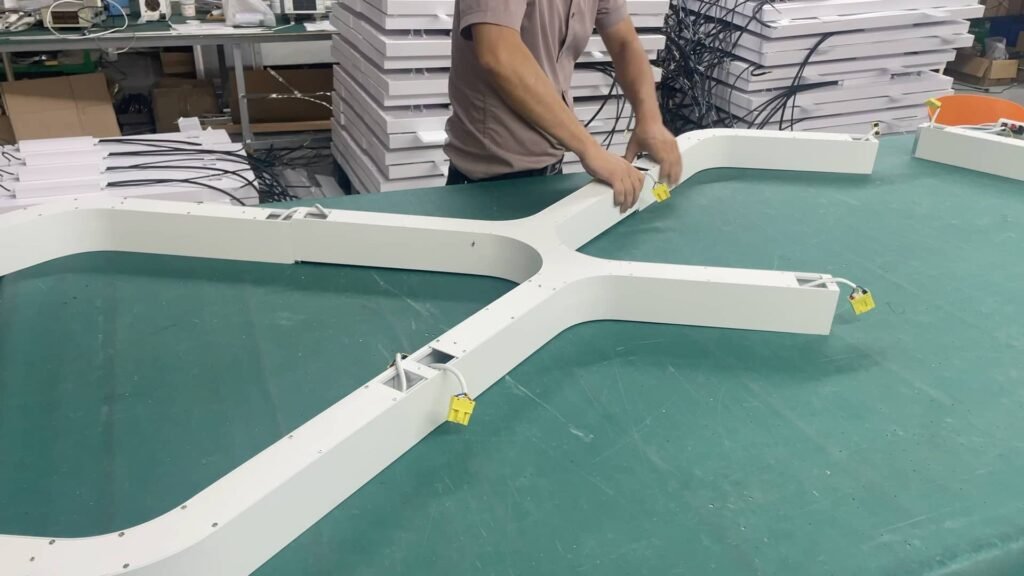
1.4 Structural Benefits: Ensuring Stability & Flexibility
When using LED linear lights, structural integrity is key. High-quality housings made from extruded aluminum offer several benefits:
Straightness & Rigidity: The material maintains its form, ensuring straight, consistent fixture runs, even in long installations.
Modular Installation Compatibility: Aluminum extrusions can be cut and joined precisely, making them ideal for large-scale projects or custom configurations.
This modular design allows flexibility in fixture layouts, whether you’re installing for a commercial or industrial space.
2. The Role of the Lens in LED Linear Lighting
When it comes to LED linear lighting, I always say the lens is just as important as the LEDs themselves. The right lens can mean the difference between a well-lit, comfortable space and one filled with harsh glare or uneven light distribution. Over the years, I’ve tested and worked with a variety of lens materials and designs, and I’ve learned exactly what works best for different applications. Let’s dive into the details so you can make an informed decision.
- Diffusion – Softens the light to reduce harsh shadows and LED “hotspots.”
- Glare Control – Helps prevent eye strain in workspaces and offices.
- Light Direction – Shapes the beam to achieve specific lighting effects.
- Protection – Shields LEDs from dust, moisture, and impact.
2.1 Lens Types: Which One Should You Choose?
Different lens styles affect light distribution in unique ways. Here’s how I break it down:
Comparison of Lens Types
| Lens Type | What It Does | Where I Recommend Using It |
|---|---|---|
| Clear Lens | Maximum brightness, but visible LEDs (can cause glare). | Warehouses, high-output areas where efficiency is key. |
| Frosted/Opal Diffuser | Softens and evenly spreads light, hiding LED points. | Offices, homes, retail spaces—where comfortable lighting matters. |
| Prismatic Lens | Tiny patterns reduce glare while directing light. | Commercial offices, classrooms, conference rooms. |
| Asymmetric Lens | Directs more light to one side (wall-wash effect). | Museums, galleries, signage lighting. |
| Batwing Lens | Spreads light horizontally for even illumination. | Open offices, supermarkets, large retail stores. |
My Go-To Choices
- For office spaces → I recommend prismatic or frosted diffusers to eliminate glare and hotspots.
- For industrial areas → A clear lens maximizes efficiency but should be placed high to avoid glare.
- For accent lighting → Asymmetric lenses work well for wall-washing or highlighting objects.
I’ve personally seen how the right lens completely transforms a space. For example, in a corporate office where employees complained about eye strain, switching to a micro-prismatic diffuser made a world of difference.
2.1 Polycarbonate (PC) vs. Acrylic (PMMA): Which Lens Material is Best?
I often get asked, “Should I choose polycarbonate or acrylic for my linear light lenses?” The answer depends on your priorities:
Material Comparison
| Feature | Polycarbonate (PC) | Acrylic (PMMA) |
|---|---|---|
| Durability & Impact Resistance | ✅ Extremely tough, flexible, resists breakage. | ❌ More brittle, can crack under pressure. |
| UV & Heat Resistance | ❌ Can yellow over time if not UV-stabilized. | ✅ Naturally UV-resistant, stays clear longer. |
| Light Transmission | 🔹 88-90% (slightly lower than acrylic). | 🔹 92-93% (better optical clarity). |
| Best For | High-traffic areas, industrial settings. | Offices, architectural lighting needing long-term clarity. |
My Personal Recommendation
- For general indoor lighting, both PC and PMMA work fine.
- For outdoor lighting or high-traffic spaces, polycarbonate is the best because it won’t shatter.
- For high-end office and retail lighting, acrylic is ideal because it offers better clarity and won’t yellow over time.
Some of the best-quality LED linear lights use a mix of PC and PMMA to combine durability and clarity—a solution I highly recommend.
2.2 Optical Design: How the Lens Affects Light Performance
Many people overlook how lens shape influences light quality. Here’s a quick guide to different optical designs I’ve worked with:
- Wide Diffuser → Produces a broad beam for even illumination.
- Narrow Lens (~20° beam) → Ideal for aisle lighting or task lighting.
- Asymmetric Lens → Directs light toward walls or displays for a highlighting effect.
- Batwing Lens → Distributes light evenly across a large space to prevent dark spots.
I’ve had cases where simply swapping the lens transformed a lighting setup. For instance, in a supermarket, switching from a standard frosted lens to a batwing diffuser improved aisle lighting while reducing the number of fixtures needed—saving energy and money.


2.3 Personal Experience: Why the Right Lens Matters
I remember a project where a client was frustrated with their LED linear lighting. They noticed pinpoint LED hotspots and multiple shadows, making the space look harsh and uneven. The issue? The wrong lens choice.
To fix this, we switched to a micro-prismatic diffuser—a simple yet effective upgrade. This specialized diffuser not only:
✔ Eliminated visible LED points, creating a smooth, uniform light output.
✔ Reduced glare by controlling how light was dispersed.
✔ Directed some light upward for soft indirect illumination, while still providing efficient downlighting.
The result? The space went from harsh and uncomfortable to evenly lit and visually pleasant, all without sacrificing brightness.
💡 Key Takeaway:
The lens in an LED linear light is crucial for controlling light distribution. Whether you need a soft, diffused glow, a focused beam, or glare-free illumination, choosing the right polycarbonate or acrylic diffuser ensures optimal light quality. For special applications, advanced optics can tailor the beam to maximize efficiency and comfort.
This experience reinforced what I always tell my clients: The lens choice can make or break a lighting design.
2.4 Color Rendering Index (CRI): Seeing Colors as They Are
The Color Rendering Index (CRI) measures an LED’s ability to accurately reproduce colors compared to a natural light source, with a maximum score of 100. CRI is especially crucial in environments where color accuracy is a priority.
CRI Ranges and Applications
CRI 80 to 89:
- Offers good color fidelity, suitable for most general lighting applications.
- Applications in LED Track Lights: Perfect for offices, schools, and residential settings where color accuracy is important but not critical.
CRI 90 and Above:
- Provides exceptional color accuracy, making colors look vibrant and true-to-life.
- Applications in LED Track Lights: Essential in galleries, retail stores, and photography studios to highlight fine details and enhance visual impact.
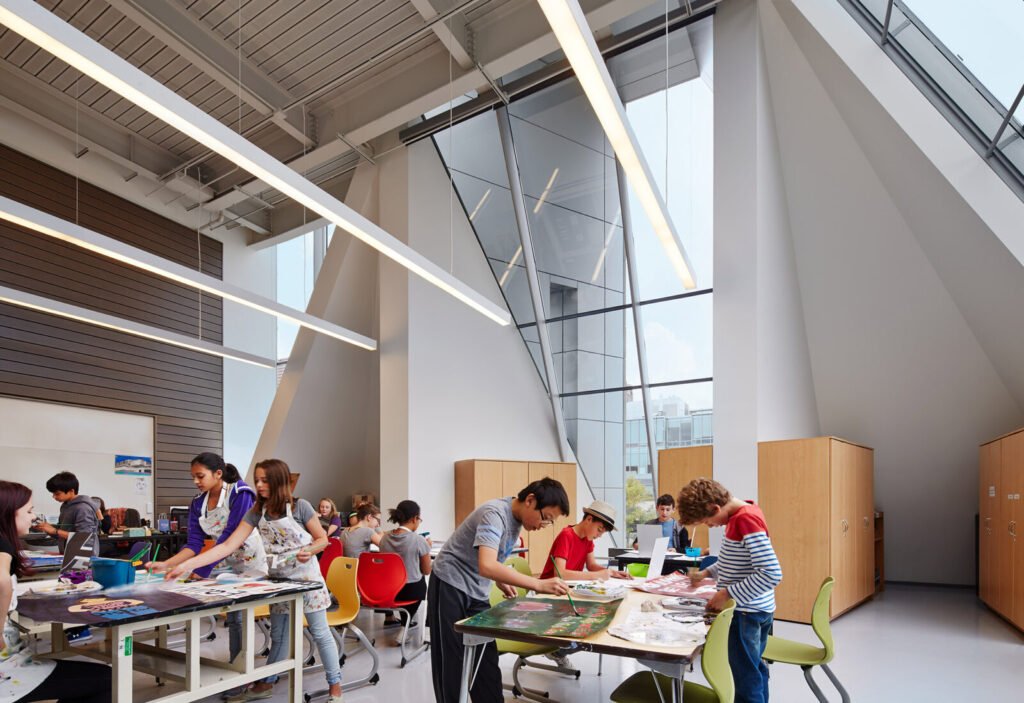
Why LED Chips Matter for LED Track Lights
- Retail Impact: High CRI lighting ensures products like clothing, jewelry, and fresh food appear as appealing as possible, influencing purchasing decisions.
- Work Environment: In creative industries, such as design or photography, high CRI lighting ensures that colors are perceived correctly, enhancing work quality.
- Enhanced Aesthetics: Spaces lit with high CRI lighting feel more vibrant and natural, improving the overall ambiance.
3. How to Choose High-Quality LED Chips for LED Linear Lights
When it comes to LED linear lighting, I always emphasize one thing: the LED chips are the heart of the fixture. Their quality directly impacts brightness, efficiency, longevity, and even how colors appear in a space. Over the years, I’ve worked with countless LED fixtures, and I’ve learned that not all LED chips are created equal. Here’s what you need to know to choose the best LED linear light.
3.1 Types of LED Chips: What’s Inside the Fixture?
Most linear LED lights use SMD (Surface Mount Device) LEDs, the small rectangular chips arranged in rows on the LED board. Some high-end fixtures use premium LED brands like Nichia, Samsung, or Cree for better efficiency and lifespan.
Common LED Chip Types & Their Benefits
| LED Chip Type | Description | Best Use Cases |
|---|---|---|
| SMD (Mid-Power LEDs) | Small, efficient, and spread across the fixture for uniform light. | General lighting (offices, homes, retail spaces). |
| COB (Chip-on-Board LEDs) | Densely packed LED arrays for a single, intense light source. | High-lumen applications (commercial spaces, warehouses). |
| LED Strip (Taped LEDs inside aluminum profile) | Flexible and modular; used in linear architectural lighting. | Accent lighting, decorative applications. |
💡 My Recommendation: I prefer mid-power SMD LEDs (typically 2835, 3030, or 5630 chips) in linear fixtures because they provide high lumens per watt, even light distribution, and lower heat generation.
3.2 LED Efficiency: Why Lumens per Watt Matters
One of the first things I check when evaluating an LED chip is its efficacy (lumens per watt, lm/W). LED technology has improved dramatically—older LEDs only managed 50–70 lm/W, but today’s mid-power LEDs easily reach 130–170 lm/W.
One of the first things I check when evaluating an LED chip is its efficacy (lumens per watt, lm/W). LED technology has improved dramatically—older LEDs only managed 50–70 lm/W, but today’s mid-power LEDs easily reach 100–150 lm/W.
Why Efficiency Matters
- Higher lm/W → More brightness with less power, reducing electricity costs.
- Lower heat output → LEDs last longer and require less cooling.
- Better energy savings → Ideal for LEED-certified buildings or sustainable projects.
For example, a 40W LED linear light can now produce 4,000–5,000 lumens, replacing two old fluorescent tubes while consuming much less power.
🔹 Pro Tip: If you need ultra-efficient lighting (e.g., a green building project), opt for top-tier LED bins (~180 lm/W at chip level, ~150 lm/W after fixture losses).

3.3 Color Temperature: Choosing the Right Ambiance
The color temperature (CCT) of an LED determines the warmth or coolness of the light. I always consider the application and user preference before selecting a CCT.
| CCT (Kelvin) | Appearance | Best Use Cases |
|---|---|---|
| 2700K–3000K (Warm White) | Soft, cozy, yellowish light. | Homes, hotels, restaurants. |
| 3500K–4100K (Neutral White) | Balanced, natural white light. | Offices, retail stores, classrooms. |
| 5000K–6500K (Cool White) | Crisp, bright, bluish daylight. | Warehouses, workshops, hospitals. |
💡 Pro Tip: Some tunable white LED linear lights allow users to adjust color temperature (e.g., shifting between 3000K and 6000K). This is great for dynamic workspaces, showrooms, or residential lighting.
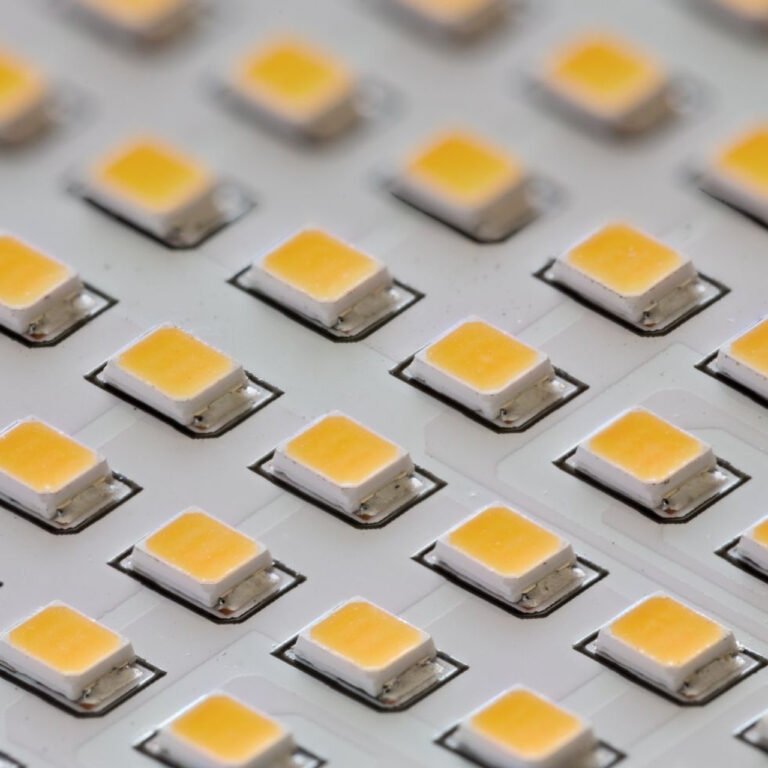

3.4 CRI (Color Rendering Index): Ensuring True-to-Life Colors
The Color Rendering Index (CRI) measures how accurately colors appear under LED lighting.
| CRI Rating | Color Accuracy | Best Use Cases |
|---|---|---|
| CRI 80+ | Standard, decent color accuracy. | Offices, warehouses, general lighting. |
| CRI 90+ | Excellent color vibrancy, true-to-life tones. | Retail, homes, high-end offices. |
| CRI 95+ | Crisp, bright, bluish daylight. | Warehouses, workshops, hospitals. |
In a fashion boutique, switching from CRI 80 to CRI 90+ made fabric colors pop and look more natural, enhancing the shopping experience.
4. PCB & Thermal Management: The Silent Workhorse of LED Linear Lights
Over the years working with LED linear lighting systems, I’ve come to truly appreciate the importance of the Printed Circuit Board (PCB) — often overlooked, yet critical to the performance, efficiency, and lifespan of any LED linear fixture.
4.1 What is a PCB in an LED Linear Light?
The PCB is the substrate on which the LED chips are mounted. It performs three vital roles:
Electrically connecting LED chips to the driver and to each other.
Thermally managing the heat generated by the LEDs.
Providing mechanical support for stable placement and alignment of the LEDs across the fixture.
In linear lights, the PCB typically runs the entire length of the fixture and houses dozens or hundreds of LED packages, depending on the length and power.

4.2 PCB Material: Why We Choose Metal-Core PCB (MCPCB)
We always use Metal-Core PCBs (MCPCB) — especially aluminum-based — instead of standard FR4 (fiberglass epoxy) PCBs for our linear light products.
✔️ Aluminum-Core PCBs (MCPCB)
Superior heat conductivity: The aluminum substrate transfers heat away from the LED junction quickly and efficiently.
Improved lifespan: Cooler LEDs last longer. A well-designed MCPCB can keep junction temperatures 20–30°C lower than FR4 boards.
Stability: Aluminum cores offer more rigidity over long lengths, reducing the risk of board warping, which could misalign optics or lenses.

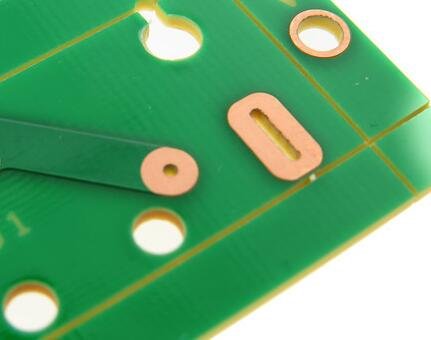
❌ FR4 (Fiberglass) PCBs
Suitable for low-power LED strips, but insufficient thermal management for high-output fixtures.
Prolonged heat buildup leads to thermal stress, early lumen depreciation, and color shift.
Not recommended for professional or industrial-grade linear lighting systems.
In essence, MCPCB is the only reliable choice for linear lights that demand high efficacy and long-term performance.
4.3 Thermal Path Design: Heat Transfer from Chip to Air
The LED chip itself generates heat at its junction point (Tj), which must be rapidly dissipated to maintain performance. We engineer the thermal path as follows:
LED Chip → Solder Pad (on PCB)
Solder Pad → Dielectric Layer (thin thermal layer on MCPCB)
Dielectric Layer → Aluminum Base
Aluminum Base → Fixture Housing (also aluminum, acts as secondary heat sink)
Housing → Ambient Air
Each layer matters. That’s why we use:
High-quality thermal dielectric material with low thermal resistance (typically <1 W/mK).
Thermal interface materials (TIMs) like thermal pads, pastes, or double-sided thermally conductive adhesive between PCB and housing — this avoids air gaps and ensures direct contact.
We also design the MCPCB layout to spread heat evenly, placing high-power LED clusters further apart when needed.


4.4 Copper Thickness & Trace Design
In addition to thermal considerations, electrical trace layout and copper weight on the PCB matter.
We use 1 to 2 oz copper thickness to handle higher currents without excessive voltage drop or self-heating.
Wider traces reduce resistance and increase current-handling capacity.
Multi-channel layouts (e.g. multiple constant-current strings) are separated to avoid thermal cross-talk and allow better dimming control.
Every trace and pad is engineered to meet the required current levels for each LED group, while minimizing EMI (Electromagnetic Interference) and power losses.
4.5 Thermal Testing & Lifetime Assurance
We rigorously test our PCB designs to ensure thermal efficiency under real-world conditions:
Thermal imaging to identify hotspots
Junction temperature (Tj) measurement using thermocouples
LM-80 and TM-21 data from our LED suppliers is used to project L70 and L90 lifetimes
Our in-house integration with the aluminum housing ensures a complete thermal solution, not just a board that “gets the job done”
Thanks to this, most of our linear light fixtures exceed:
L70 @ 50,000–100,000 hours
L90 @ 30,000–60,000 hours, depending on drive current and ambient temperature
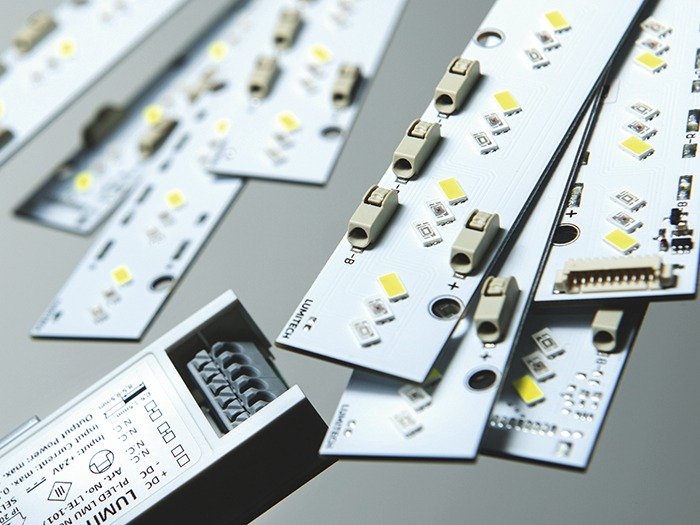
FAQS
Advanced LED Linear Light FAQs – Technical & Project-Oriented
UGR (Unified Glare Rating) is critical in environments like offices, classrooms, and healthcare facilities. For a UGR<19 rating, linear lights must be designed with specific optics, lensing, and light distribution. Lowcarbon uses micro-prismatic diffusers and deep reflectors to achieve compliance with EN 12464-1, ensuring visual comfort and European-standard conformity.
PCB quality directly affects thermal conductivity and current handling. We typically use 1.6mm aluminum PCBs with 2 oz copper thickness, ensuring efficient heat dissipation and stable voltage across long linear runs. Poor PCB design can lead to LED burnout, flicker, or early driver failure—a risk for long-term installations.
Flicker-free performance requires high-frequency constant current drivers with low ripple. We work with Lifud, Tridonic, and Philips to ensure compatibility with DALI-2, 0-10V, and TRIAC dimming, providing smooth transitions with no visible flicker, meeting IEEE 1789 flicker safety standards.
Yes. Our DALI-compatible LED linear lights are fully addressable, ideal for KNX or Lutron-based building automation systems. We offer custom driver programming, group addressing, and scene setting support, perfect for high-end architectural or BMS-integrated projects.
With precise LED spacing, PCB consistency, and connector design, our systems can achieve up to 20 meters of seamless light without visual gaps. We use internal joiners, alignment pins, and consistent binning (SDCM <3) to ensure uniformity across long runs.
We use MacAdam Step <3 (SDCM<3) for all LEDs, with single-batch binning to maintain consistent color temperature across batches. For large projects, we reserve LED bins in advance to avoid shift between phases of installation.
Suspended linear lights have better airflow and thus improved passive cooling, ideal for higher-wattage outputs. Recessed lights require advanced thermal design and low-profile heatsinks to prevent heat buildup in ceiling cavities. We adjust driver location and heatsink volume accordingly.
Booking
Get in Touch with Us
Customized LED Lighting Solutions
Ready to start your project? Our team is here to provide personalized assistance and answer any questions you may have. Whether you need help with a custom design or just want more information, we’re ready to assist you every step of the way.
Send Us a Message
Fill out the form, and we’ll get back to you within 24 hours.
Our Staff Will Call You
Expect a quick response to discuss your needs.
Get a Quote
We’ll provide a tailored solution and competitive pricing for your project.

